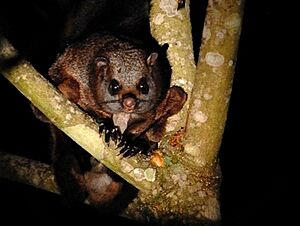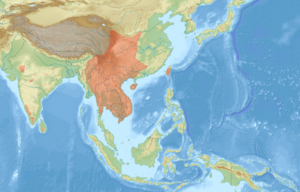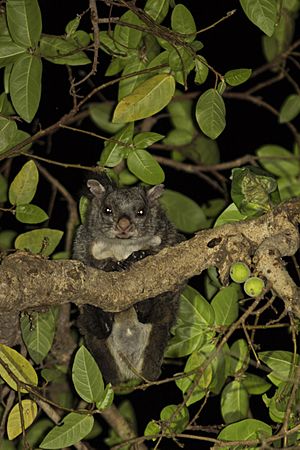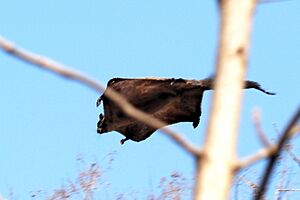Indian giant flying squirrel facts for kids
Quick facts for kids Indian giant flying squirrel |
|
|---|---|
 |
|
| Conservation status | |
| Scientific classification | |
| Genus: |
Petaurista
|
| Species: |
philippensis
|
 |
|
| Range in red as reported by the IUCN, but see text | |
The Indian giant flying squirrel (Petaurista philippensis) is also known as the large brown flying squirrel or the common giant flying squirrel. It's a type of rodent in the Sciuridae family, which includes squirrels. This amazing animal can glide through the air using a special skin flap called a patagium. This flap stretches between its front and back legs. You can find these squirrels in parts of Southeast and South Asia, and also in southern and central China.
Contents
What they look like

These are big squirrels! Their head and body together are about 43 cm long, and their tail adds another 50–52 cm. They have fur that can be black or gray-brown. The fur on their back is long and soft, while the fur underneath is a bit shorter.
The special skin flap, or "wing membrane," is lighter in color underneath. This flap helps them glide from tree to tree. Their tail is bushy and blackish to gray-brown. Their feet are black, and their nose is a light pink with black whiskers.
About their family tree
Scientists have found that understanding the Indian giant flying squirrel's family tree, or taxonomy, can be tricky. For a long time, some people thought it was just a type of red giant flying squirrel. But newer studies have shown that the Indian giant flying squirrel is its own unique species.
For example, the Formosan giant flying squirrel from Taiwan and the Hainan giant flying squirrel from Hainan are now known to be different species. The Yunnan giant flying squirrel, found in places like northeastern India and China, is also a separate species. Even though some of these other flying squirrels live in similar areas, they are not the same as the Indian giant flying squirrel.
In 1900, a new type of Indian giant flying squirrel was found in Nan, Thailand. It was named Petaurista philippensis lylei after Harold Lyle, who was a British consul there.
Where they live and their home

These squirrels live in several countries, including China, India, Laos, Myanmar, Sri Lanka, Taiwan, Thailand, and Vietnam. They like to live in dry deciduous forests (where trees lose their leaves) and evergreen forests (where trees keep their leaves all year).
They usually live at higher places, from about 500 to 2000 meters (about 1,640 to 6,560 feet) above sea level. You might even spot them in plantations, which are areas where trees are grown by people.
How they live
The Indian giant flying squirrel is nocturnal, meaning it is active mostly at night. It is also arboreal, which means it spends most of its life in trees. They build their nests inside hollow parts of trees. They line these nests with soft materials like bark, fur, moss, and leaves.
These squirrels can be friendly with each other when there's plenty of food around. However, if food becomes scarce, they might fight with other squirrels of their own kind. Their calls sound a bit like the calls of a spot-bellied eagle-owl.
What they eat
These squirrels mainly eat fruit, so they are called frugivorous. They especially love the fruits from Ficus racemosa trees. They also enjoy fruits from Cullenia and Artocarpus heterophyllus (which is the jackfruit tree).
Besides fruit, they also eat tree bark, sticky tree resins, young shoots, and leaves (especially from F. racemosa trees). Sometimes, they will eat insects and their larvae (young insects). These squirrels are quite good at finding food, even near the edges of forests or in areas where people have planted new trees.
Reproduction and life cycle
Female Indian giant flying squirrels usually give birth to one baby at a time, around the middle of June. When the babies are born, they cannot see yet. Their heads are also much bigger compared to the rest of their body.
See also


